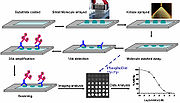
Chemical Compound Microarray
Encyclopedia
A chemical compound microarray is a collection of organic chemical compounds spotted on a solid surface, such as glass and plastic. This microarray format is very similar to DNA microarray
, protein microarray
and antibody microarray
. In chemical genetics research, they are routinely used for searching proteins that bind with specific chemical compounds, and in general drug discovery research, they provide a multiplex
way to search potential drugs for therapeutic targets.
There are three different forms of chemical compound microarrays based on the fabrication method. The first form is to covalently immobilize the organic compounds on the solid surface with diverse linking techniques; this platform is usually called Small Molecule
Microarray, which is invented and advanced by Dr. Stuart Schreiber
and colleagueshttp://cgr.harvard.edu/macbeath/research/small_mol.html. The second form is to spot and dry organic compounds on the solid surface without immobilization, this platform has a commercial name as Micro Arrayed Compound Screening (µARCS), which is developed by scientists in Abbott Laboratories http://jbx.sagepub.com/cgi/content/abstract/9/1/12. The last form is to spot organic compounds in a homogenous solution without immobilization and drying effect, this platform is developed by Dr. Scott Diamond http://www.seas.upenn.edu/~diamond/ and later commercialized as DiscoveryDot technology by Reaction Biology Corporation http://www.reactionbiology.com.
Polymer Microarrays
Polymer microarrays have been developed to allow screening for new polymeric materials to direct different tissue lineages. Research has also been directed towards studying the surface chemistry of these arrays to determine which surface chemistries control cell adhesion.

DNA microarray
A DNA microarray is a collection of microscopic DNA spots attached to a solid surface. Scientists use DNA microarrays to measure the expression levels of large numbers of genes simultaneously or to genotype multiple regions of a genome...
, protein microarray
Protein microarray
A protein microarray, sometimes referred to as a protein binding microarray,provides a multiplex approach to identify protein–protein interactions, to identify the substrates of protein kinases, to identify transcription factor protein-activation, or to identify the targets of biologically active...
and antibody microarray
Antibody microarray
An antibody microarray is a specific form of protein microarrays, a collection of capture antibodies are spotted and fixed on a solid surface, such as glass, plastic and silicon chip for the purpose of detecting antigens...
. In chemical genetics research, they are routinely used for searching proteins that bind with specific chemical compounds, and in general drug discovery research, they provide a multiplex
Multiplex (assay)
A multiplex assay is a type of laboratory procedure that simultaneously measures multiple analytes in a single assay. It is distinguished from procedures that measure one or a few analytes at a time...
way to search potential drugs for therapeutic targets.
There are three different forms of chemical compound microarrays based on the fabrication method. The first form is to covalently immobilize the organic compounds on the solid surface with diverse linking techniques; this platform is usually called Small Molecule
Small molecule
In the fields of pharmacology and biochemistry, a small molecule is a low molecular weight organic compound which is by definition not a polymer...
Microarray, which is invented and advanced by Dr. Stuart Schreiber
Stuart Schreiber
Stuart L. Schreiber is a scientist at Harvard University and the Broad Institute. He has been a pioneer in a field of research named chemical biology for over 20 years. His name is closely associated with the increasingly common use of small molecules as probes of biology and medicine...
and colleagueshttp://cgr.harvard.edu/macbeath/research/small_mol.html. The second form is to spot and dry organic compounds on the solid surface without immobilization, this platform has a commercial name as Micro Arrayed Compound Screening (µARCS), which is developed by scientists in Abbott Laboratories http://jbx.sagepub.com/cgi/content/abstract/9/1/12. The last form is to spot organic compounds in a homogenous solution without immobilization and drying effect, this platform is developed by Dr. Scott Diamond http://www.seas.upenn.edu/~diamond/ and later commercialized as DiscoveryDot technology by Reaction Biology Corporation http://www.reactionbiology.com.
Polymer Microarrays
Polymer microarrays have been developed to allow screening for new polymeric materials to direct different tissue lineages. Research has also been directed towards studying the surface chemistry of these arrays to determine which surface chemistries control cell adhesion.


